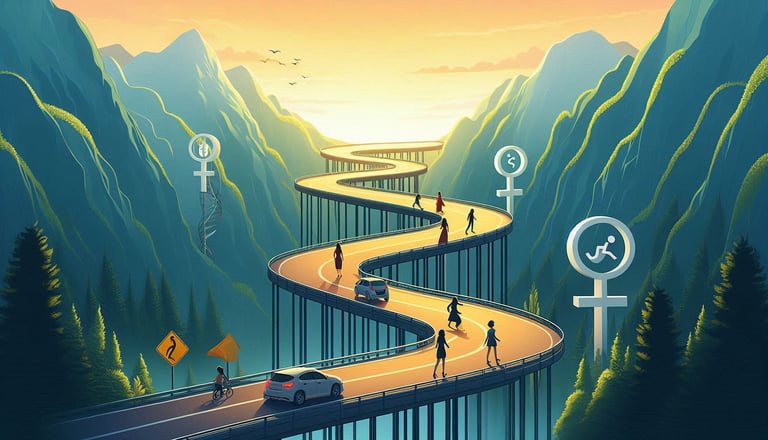The Pursuit of Gender Equality: A Long and Winding Road
Mannan Samad
University Law College, Quetta
This Blog is written by Mannan Samad, a Fifth-Year Law Student of University Law College, Quetta


Introduction
There is no denying the fact that gender equality acts as a primary driver for the development of social, economic, and political indicators, paving the way for sustainable global progress. However, the road to gender equality has always been long, tough, and winding. The Secretary-General of the United Nations (UN), Antonio Guterres, admitted the dismal global progress on women’s rights as he warned the increasingly distant goal of gender equality will take another three centuries to achieve. In this blog, I would like to cover the current state of gender equality, its historical background, underlying barriers, and the road ahead, given the long-standing struggle in the pursuit of gender equality.
Viewing Historical Context
From ancient civilization to the medieval period and the early modern period to the present era, the history of gender equality is ancient, with women being deprived of fundamental human rights such as the right to vote, education, health, fair pay, ownership of property, and representation in all aspects of life. The feminist movement spanning the 1960s and 1970s heralded a gigantic turning point in the pursuit of gender equality. Feminist icons like Gloria Steinem, Betty Friedan, and Simone de Beauvoir dismantled gender stereotypes that impeded the way of achieving gender equality. The feminist movement's emphasis was fair and equal pay, reproductive rights, and representation in all sectors of life. The movement created a generation of feminists, advocating for gender equality. Other key figures like Rosa Parks, Malala Yousafzai, and Ruth Bader Ginsburg have also played a central role in promoting gender equality. But today, this fight for gender equality is not led by certain global icons but by millions of people echoing equal rights and opportunities for both men and women, signaling a bright future where men and women work and succeed together.
A Glance on the Current State of Gender Equality
Sadly, no country has achieved gender equality in 2024. As far as the current rate of progress is concerned, it will take another 131 years to achieve gender equality globally. Statistics concerning gender equality are very poor and disturbing. According to United Nations Women 2024, 10% of today's world leaders are women. The report of the World Bank for 2024 states that women enjoy less than two-thirds of the legal rights provided to men. Despite the continued struggle for equal pay, the gender pay gap is at 20% across the world. The World Health Organization revealed the statistics of 2021 that one in three women globally has already suffered physical, partner violence and non-partner sexual violence. According to a UN Women (2022) report, a woman or girl is killed by a member of her own family every 11 minutes. The report further states that. 800 women die every day globally due to pregnancy and childbirth. Around 40% of women reside in countries where abortion laws are strict. Approximately 270 million women across the world are denied modern contraception. These statistics show the current state of gender equality is highly alarming.
Underlying Barriers Towards Gender Equality
There are numerous barriers and obstacles in the way of achieving gender equality. The key factors hindering women's rights and emancipation include gender stereotypes and discrimination, the patriarchal system, male-dominated institutions, systemic gender discrimination, limited representation, and societal and cultural traditions. The fight led by men, women, activists, and influencers is persistent in dismantling gender stereotypes and biases and resisting these barriers and challenges. Unfortunately, the advocacy efforts for gender equality are discouraged on a larger scale. The voices of women's rights are suppressed. Those who are vocal against gender discrimination face online harassment and threats daily. They are accused of being foreign agents and are on a certain agenda to achieve nefarious designs, thus undermining the cause of gender equality.
The Road Ahead
The struggle for achieving gender equality tends to continue with several periodical movements and initiatives, echoing equal rights and opportunities for both men and women. We are witnessing change and progress, but greater collaboration and inclusivity are required to address system barriers that cause gender-based discrimination. The road ahead requires a holistic approach to investing in gender-sensitive education and awareness policies to challenge gender stereotypes and biases. We must accept gender equality is not only a women's issue but a human issue; thus, we should address it as a whole.
Conclusion
In a nutshell, the pursuit of gender equality is a complex, long, and winding journey, coupled with hindrances and achievements. Therefore, it is imperative to herald a change, dismantle gender stereotypes, and address systemic barriers to achieving gender equality. Together, we can build a gender-equal world where both genders—men and women—can thrive together without any obstacles and discrimination.
References
· https://www.statista.com/chart/11667/the-long-road-to-gender-equality/2023/
· https://www.undp.org/sustainable-development-goals/gender-equality/2021/
